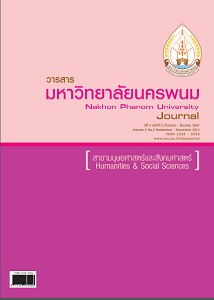การเปรียบเทียบผลการเรียนและความสามารถในการคิดวิเคราะห์ เรื่อง ระบบเครือข่าย และการใช้อินเทอร์เน็ต ของนักเรียนชั้นมัธยมศึกษาปีที่ 2 ที่เรียนด้วยบทเรียนที่ใช้ เว็บเทคโนโลยีแบบ Big six skills กับการสอนปกติ
Main Article Content
บทคัดย่อ
การวิจัยครั้งนี้มีวัตถุประสงค์เพื่อ 1) พัฒนาบทเรียนที่ใช้เว็บเทคโนโลยีแบบ Big Six Skills 2) หาค่าดัชนีประสิทธิผลของบทเรียน ที่ใช้เว็บเทคโนโลยีแบบ Big Six Skills 3) เปรียบเทียบผลสัมฤทธิ์ทางการเรียน ความสามารถในการคิดวิเคราะห์และทักษะปฏิบัติของ นักเรียนที่เรียนด้วยบทเรียนที่ใช้เว็บเทคโนโลยีแบบ Big Six Skills ระหว่างก่อนเรียนและหลังเรียน และ 4) เปรียบเทียบผลสัมฤทธิ์ ทางการเรียน ความสามารถในการคิดวิเคราะห์และทักษะปฏิบัติของนักเรียนระหว่างที่เรียนด้วยบทเรียนที่ใช้เว็บเทคโนโลยีแบบ Big Six Skills กับการสอนปกติ กลุ่มตัวอย่างที่ใช้ในการวิจัยคือนักเรียนชั้นมัธยมศึกษาปีที่ 2 จำนวน 60 คน แบ่งเป็น โรงเรียนนาสีนวนพิทยา สรรค์ จำนวน 30 คน เป็นกลุ่มทดลอง โรงเรียนศรีสุขพิทยาคม จำนวน 30 คน เป็นกลุ่มควบคุม ได้มาโดยการสุ่มแบบกลุ่ม เครื่องมือ ที่ใช้ในการวิจัย ได้แก่ บทเรียนที่ใช้เว็บเทคโนโลยีแบบ Big Six Skills แบบทดสอบวัดผลสัมฤทธิ์ทางการเรียน ซึ่งมีความยาก ระหว่าง 0.60 ถึง 0.77 ค่าอำนาจจำแนก ระหว่าง 0.23 ถึง 0.56 ค่าความเชื่อมั่นทั้งฉบับ เท่ากับ 0.87 และแบบทดสอบวัดความสามารถใน การคิดวิเคราะห์ ซึ่งมีความยาก ระหว่าง 0.60 ถึง 0.80 ค่าอำนาจจำแนก ระหว่าง 0.30 ถึง 0.52 ค่าความเชื่อมั่นเท่ากับ 0.80 สถิติที่ใช้ ในการวิเคราะห์ข้อมูล ได้แก่ ค่าเฉลี่ย ส่วนเบี่ยงเบนมาตรฐาน การวิเคราะห์สมมติฐานใช้ Hotelling T2 ผลการวิจัยพบว่า 1) บทเรียนที่ ใช้เว็บเทคโนโลยีแบบ Big Six Skills มีประสิทธิภาพเท่ากับ 84.56/88.67 2) บทเรียนที่ใช้เว็บเทคโนโลยีแบบ Big Six Skills มีค่าดัชนี ประสิทธิผลเท่ากับ 0.8038 แสดงว่านักเรียนมีความก้าวหน้าทางการเรียนเพิ่มขึ้น 0.8038 หรือคิดเป็น ร้อยละ 80.38 3) นักเรียนกลุ่ม ทดลองที่เรียนด้วยบทเรียนที่ใช้เว็บเทคโนโลยีแบบ Big Six Skills มีคะแนนเฉลี่ยหลังเรียนสูงกว่าก่อนเรียนอย่างมีนัยสำคัญทางสถิติที่ ระดับ .01 4) นักเรียนกลุ่มทดลองมีคะแนนเฉลี่ยสูงกว่านักเรียนกลุ่มควบคุมอย่างมีนัยสำคัญทางสถิติที่ระดับ .01
A Comparison of Learning Achievements and Critical Thinking Abilities on the System of Network and the Use of the Internet among Mathayom Suksa 2 Students by means of Big Six Skills with Web Technology versus Traditional Learning
Suphatree Wohgwor, Suthipong Hoksuwan and Atcha Khatbumrung
The purposes of this study were: 1) to develop lessons which employ Big Six Skills with Web Technology, 2) to examine an effectiveness index of the lessons that employ Big Six Skills with Web Technology, 3) to compare the learning achievements, the critical thinking abilities and the practical skills of students who learn with lessons which employ Big Six Skills with Web Technology before and after learning, and 4) to compare the learning achievements, the critical thinking abilities and the practical skills of students who learned with the lessons by Big Six Skills with Web Technology versus traditional learning. The sample selected by cluster random sampling was 60 Mathayom Suksa 2 students of whom 30 were from Nasinuan Phitthayasan School. This group was used as a treatment group, while the other group of 30 from Ban Srisuk Phitthayakhom was used as a control group. The instruments used were: the lessons which employ Big Six Skills with Web Technology; a learning achievement test whose difficulty values ranged between 0.60 and 0.77; discrimination power values between 0.23 and 0.56, and entire reliability value was 0.87; and a test of critical thinking abilities whose difficulty values ranged between 0.60 and 0.80, discrimination power values between 0.30 and 0.52, and reliability value was 0.80. Statistics used to analyze data were mean, standard deviation and Hotelling T2 for hypothesis testing. The findings revealed as follows: 1) The lessons which employ Big Six Skills with Web Technology had efficiency of 84.56/88.67; 2) the lessons which employ Big Six Skills with Web Technology had an effectiveness index of 0.8038 which shows that the students had an increased learning advance of 80.38%; 3) the students of treatment group who learned with the lessons by Big Six Skills with Web Technology had a significantly higher mean score after the learning than that before the learning at the .01 level; 4) the students of treatment group had a significantly higher mean score than those of control group at the .01 level.


